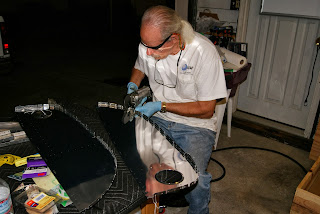Because the RV-12 is being built with flush rivets, the skins in that area are being dimpled so I tapered the holes slightly to accommodate the dimples. The forward most hole was left alone because that hole is common to the rear window.
Red circle denotes hole that was not tapered because it is common with the rear window which receives no dimpling. Note the drawing does not show the holes in the aft portion of the F-1232A brace.
This drawing shows the holes in the aft portion
of the F-1232A brace.
Dimpling the F-1232B roll bar mounting brackets
where they will contact the turtle deck skins.
During the rain delays moved ahead and prepped more
parts … the F-1254-L&R roll bar support frame, F-1234-L&R canopy decks,
and baggage bulkhead components were deburred and dimpled. The F-1277-L&R turtle
deck skins were also dimpled for flush rivets except for the holes common to
the rear window.
Dimpling one of the F-1254 roll bar support
frames for #30-120 degree flush rivets where it attaches to the fuselage side
skin.
The F-1207C-L&R baggage bulkheads come
folded in half - unfolding breaks off the tabs holding the pieces together
leaving the tabs seen in the photo.
Using the nibbling tool to remove the tabs from
the F-1207C baggage bulkhead.
Dimpling the nutplate rivet holes in the F-1207D
baggage bulkhead channels.
Dimpling the outer flanges on the
F-1207C-L&R baggage bulkheads for #30-120 degree flush rivets.
Dimpling one of the F-1277 turtle deck skins
using a #30-120 degree dimple die for the flush rivets being used on the RV-12
project.
Also worked on a few miscellaneous parts such as
the F1207E-L&R shoulder strap lug (which
required machine countersunk for the flush rivets being used in the project) along
with the F-1270D doubler for the side skin stiffening retro fit. Because the
F-1270D doubler is relatively thin, it was secured to both F-1270 side skin
doublers (placed back to back) which also have the same rivet hole pattern. This
worked great and prevented rivet hole elongation from the machine countersink
process.
Machine countersinking for #30-120 degree flush
rivets the F-1270D doubler. The doubler was secured onto the much thicker F-1270
side skin doublers (which were placed back to back) with Clecos. This prevented
hole elongation.
Machine countersinking the F-1207E shoulder
strap lugs for #30-120 degree flush rivets. It was easier to countersink the
holes prior to separating the two lugs on the band saw.
F-1207E-L&R shoulder strap lugs after
machine countersinking with a #30-120 degree bit.
Finally after a couple of days of weather not
conducive for painting, late this afternoon all the components worked on over
the last week were finally primed with Akzo primer after receiving a good
cleaning with Acetone and scuffing with Scotch-Brite pads.












